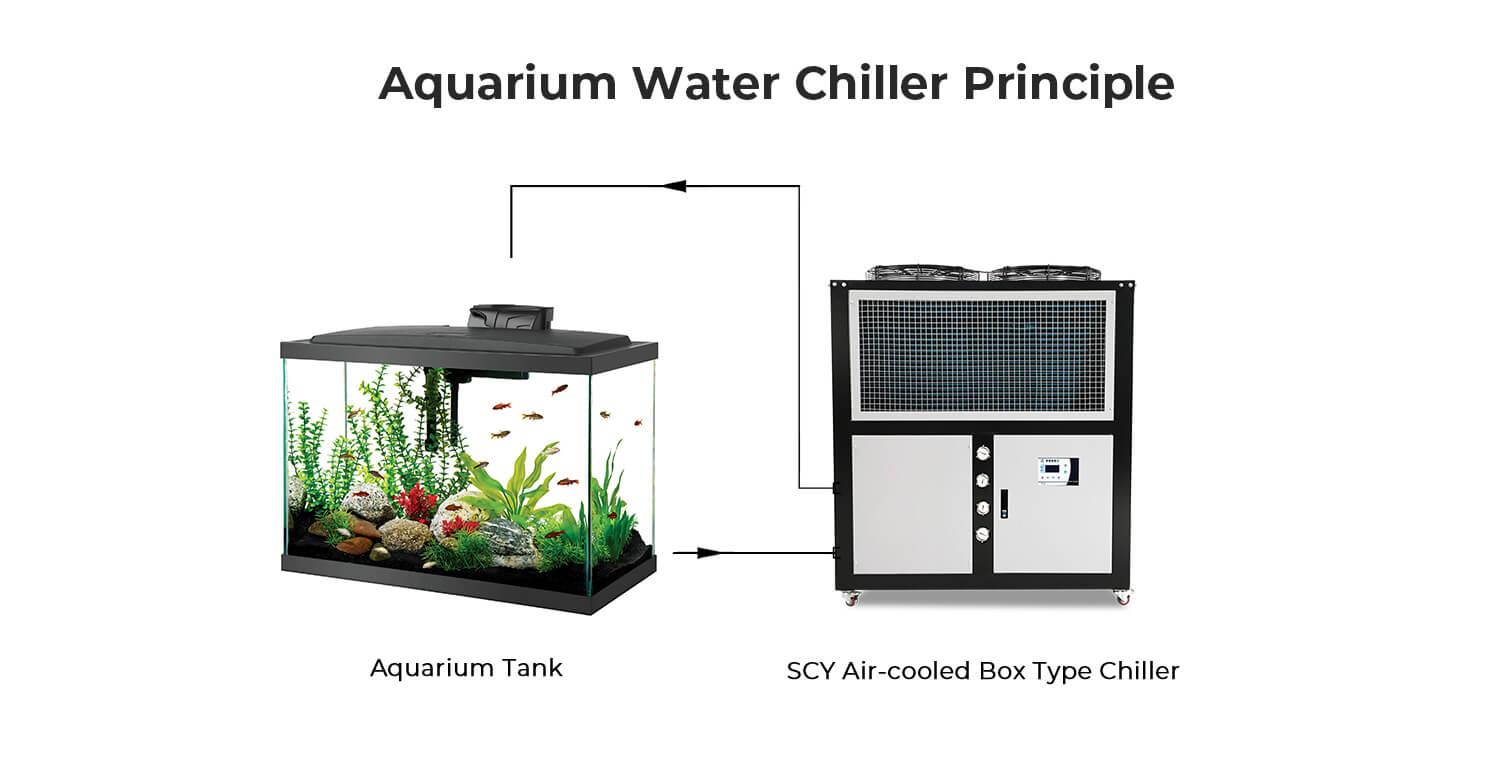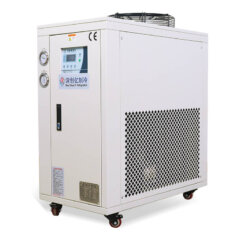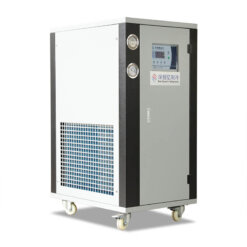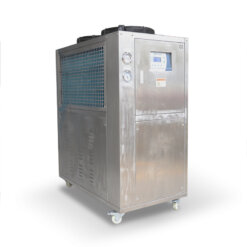How Does an Aquarium Chiller Work?

Aquarium chillers play an essential role in maintaining an optimal and steady temperature for aquatic life. They function using the vapor-compression method, a process that may seem complex but can be understood through the basic principles and components involved. This explanation breaks down how an aquarium chiller works, emphasizing the significant parts and their roles in the cooling process.
- Heat Exchange: The process starts when aquarium water is pumped into the chiller and enters the heat exchanger. In the heat exchanger, the aquarium water circulates around a series of metal coils filled with refrigerant. Here, the heat from the aquarium water is transferred to the refrigerant, thereby cooling the water.
- Compressor: The refrigerant, now heated, is compressed in the compressor, transitioning from a liquid state to a gaseous state. The compressor’s pressure propels the refrigerant through the cooling system.
- Condenser and Fan: The gaseous refrigerant is propelled by pressure from the compressor into the condenser. A fan then blows air over the condenser, which cools the refrigerant inside and expels heat into the surrounding atmosphere. This process resembles how a car radiator functions. Thus, the chiller should be situated in a well-ventilated area to ensure efficient heat dissipation.
- Refrigerant Transformation: As the refrigerant navigates through the condenser, it cools down and reverts back into a liquid state.
- Expansion Valve: The liquid refrigerant moves from the condenser through an expansion valve, which reduces pressure inside the refrigerant line. This valve controls the rate at which the aquarium water is cooled inside the evaporator or heat exchange.
- Temperature Controller: Finally, a temperature controller closely monitors the temperature of the aquarium water. It automatically activates the chiller when the water temperature increases and deactivates it when the temperature is within the desired range. This controller is generally built into most chillers, but depending on the chiller’s brand, it may be sold separately.
Through this six-step process, an aquarium chiller effectively and efficiently cools your aquarium water, promoting a healthy environment for the aquatic life within.
Choosing The Right Chiller Using Ton/BTU
Selecting the correct aquarium chiller entails more than merely considering your aquarium’s capacity. You also need to take into account the desired temperature drop and the surrounding air temperature.
When aiming to reduce the water temperature by 3-5°F (approx. 1.5-2.7°C), the chiller you need won’t be as powerful as when you’re trying to decrease it by 10-15°F (approx. 5.5-8.3°C). It’s also important to note that as the ambient temperature increases (above around 75°F or 24°C), the efficiency of the chiller decreases. If the ambient temperature exceeds 78°F (approx. 25.5°C), the chiller might not be able to cool effectively or at all.
Choosing the right chiller can be facilitated using a standard estimation formula that utilizes Cooling Tons (or BTUs – British Thermal Units). A Cooling Ton is a measurement that indicates the amount of heat energy the chiller can remove per hour. Chiller manufacturers generally provide this rating. However, this formula assumes that the chiller is positioned in an area with moderate ambient temperatures, around 70°F (approx. 21°C), and does not take into account additional heat sources.
By considering the desired temperature drop, the surrounding air temperature, and the cooling ton rating of the chiller, you can more accurately select the right chiller for your aquarium’s specific needs.
There are also specific rules for low temperature(lower than 5°c) chiller sizing. Please feel free to contact us.
There are also specific rules for low temperature(lower than 5°c) chiller sizing. Please feel free to contact us.
What Parameters Do You Need to Get the Right Chiller Tonnage
Fill in the boxes with the following three parameters to get the estimated chiller size you need for your application.
- The flow rate
- The incoming water temperature
- The chilled water temperature you require
Chiller Tonnage Calculation Formula
- Calculate Temperature Differential = Incoming Water Temperature (°c) – Required Chilled Water Temperature
- Calculate the water flow rate that you need per hour(m³/hour)
- Calculate tons of cooling capacity = Water Flow Rate x Temp. Differential ÷ 0.86 ÷ 3.517
- Oversize the chiller by 20% Ideal Size in Tons = Tons x 1.2
- You have the ideal size for your needs
For example, what size of chiller is required to cool 5m³ water from 25°c to 15 °c in 1 hour?
- Temperature Differential = 25°c-15°c=10°c
- Water Flow Rate = 5 m³/hour
- Ton Capacity = 5 x 10 ÷ 0.86 ÷ 3.517 = 16.53 Tons
- Oversize the chiller = 16.53 x 1.2 = 19.84 Tons
- A 19.84 Tons chiller is required
Do I Really Need a Chiller?
In a temperature-controlled environment, utilizing modern LED lighting and DC-powered water pumps, the majority of aquariums don’t necessarily require a chiller. Maintaining ambient temperatures around 70°-72° F (21°-22° C) throughout the year is typically sufficient for most setups.
Older technologies like AC-powered pumps, metal halide, and high-output fluorescent lighting, which transfer significant heat into the aquarium water, were traditionally the main reasons for aquarium owners to invest in chillers. However, with advancements in aquarium technology leading to more efficient and cooler operating equipment, the need for chillers in tropical reef aquariums has greatly diminished. If a chiller is needed, the temperature drop required is usually minimal.
However, if you intend to house cold-water species requiring water temperatures in the low 70s or even 60s (21°-15° C), a more powerful chiller becomes necessary. Understanding your specific needs, the species you intend to keep, and the environmental conditions of your aquarium will ultimately dictate whether a chiller is an essential investment for your setup.




Great blog, keep up the superb work.
hola, tengo una pecera de 300L por favor podrian apoyarme con asesoria?
tengo un ajolote que requiere el agua a 18-22 °C
Hola Julia, pues estoy como tu. Tengo una pareja de ajolotes, que según he estado mirando en diversos sitios, requieren una temperatura del agua entre 15 y 18 ºC. He comprado un ventilador de la leche (pero no vale para nada, no consigue enfriar ni un grado). Pienso que la única solución será un enfriador por gases, tal como comenta el blog pero solo he visto modelos de 600€ para arriba. Si alguien nos puede echar una mano con este tema estaríamos muy agradecidos. Un saludo